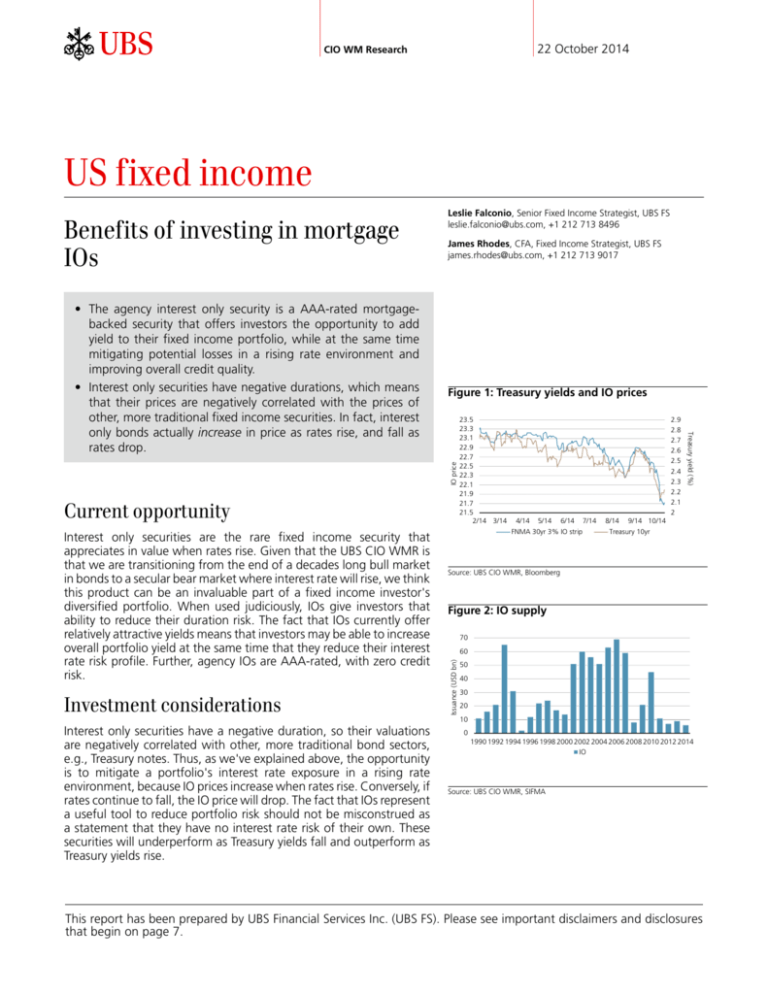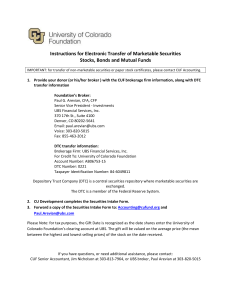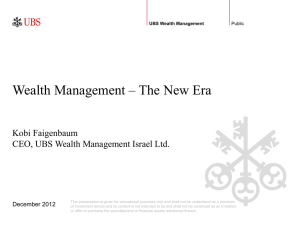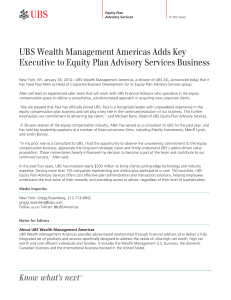
22 October 2014
CIO WM Research
US fixed income
Benefits of investing in mortgage
IOs
James Rhodes, CFA, Fixed Income Strategist, UBS FS
james.rhodes@ubs.com, +1 212 713 9017
IO price
Figure 1: Treasury yields and IO prices
Current opportunity
Investment considerations
Interest only securities have a negative duration, so their valuations
are negatively correlated with other, more traditional bond sectors,
e.g., Treasury notes. Thus, as we've explained above, the opportunity
is to mitigate a portfolio's interest rate exposure in a rising rate
environment, because IO prices increase when rates rise. Conversely, if
rates continue to fall, the IO price will drop. The fact that IOs represent
a useful tool to reduce portfolio risk should not be misconstrued as
a statement that they have no interest rate risk of their own. These
securities will underperform as Treasury yields fall and outperform as
Treasury yields rise.
2.9
2.8
2.7
2.6
2.5
2.4
2.3
2.2
2.1
2
4/14
5/14
6/14
FNMA 30yr 3% IO strip
7/14
8/14
9/14 10/14
Treasury 10yr
Source: UBS CIO WMR, Bloomberg
Figure 2: IO supply
70
60
Issuance (USD bn)
Interest only securities are the rare fixed income security that
appreciates in value when rates rise. Given that the UBS CIO WMR is
that we are transitioning from the end of a decades long bull market
in bonds to a secular bear market where interest rate will rise, we think
this product can be an invaluable part of a fixed income investor's
diversified portfolio. When used judiciously, IOs give investors that
ability to reduce their duration risk. The fact that IOs currently offer
relatively attractive yields means that investors may be able to increase
overall portfolio yield at the same time that they reduce their interest
rate risk profile. Further, agency IOs are AAA-rated, with zero credit
risk.
23.5
23.3
23.1
22.9
22.7
22.5
22.3
22.1
21.9
21.7
21.5
2/14 3/14
Treasury yield (%)
• The agency interest only security is a AAA-rated mortgagebacked security that offers investors the opportunity to add
yield to their fixed income portfolio, while at the same time
mitigating potential losses in a rising rate environment and
improving overall credit quality.
• Interest only securities have negative durations, which means
that their prices are negatively correlated with the prices of
other, more traditional fixed income securities. In fact, interest
only bonds actually increase in price as rates rise, and fall as
rates drop.
Leslie Falconio, Senior Fixed Income Strategist, UBS FS
leslie.falconio@ubs.com, +1 212 713 8496
50
40
30
20
10
0
1990 1992 1994 1996 1998 2000 2002 2004 2006 2008 2010 2012 2014
IO
Source: UBS CIO WMR, SIFMA
This report has been prepared by UBS Financial Services Inc. (UBS FS). Please see important disclaimers and disclosures
that begin on page 7.
US fixed income
Figure 3: Mortgage loans collateralize myriad
mortgage-backed securities, including IOs
Different Risk and Return for Different Investors
B
B
B
AAA/Aaa
B
B
B
Pool of
Mortgage
Loans
B
B
B
B
B
B
AA/Aa
A/A
BBB/Baa
B
BB/Ba
B
Unrated
B/B
B
B
First
Loss
Highest
Higher
Risk
Expected
Yield
Source: UBS CIO WMR
Prepay Speed (CPR)
Figure 4: Mortgage prepayment speeds and IO
prices
60
35
50
30
25
40
20
30
15
20
10
10
0
-300
5
0
-200
-100
0
100
Interest rate shock (bps)
CPR
IO
200
300
IO Price (vs 100 par)
This is an important distinction that makes IO securities very different
than most other fixed income securities. That's because, all else equal,
prepayment activity is negatively related to the level of interest rates
(i.e., as rates fall, the incentive for a borrower to prepay a loan incrementally increases) – and since IO valuations are also negatively related to prepayment activity – the IO valuations are actually expected to
increase as interest rates rise, unlike most other fixed income counterparts. In fact, IOs have negative durations. This means that not only
do IO prices move in the opposite direction as, for example, Treasury
notes; but do so in an asymmetrical fashion, with the IO showing price
declines in Treasury market rallies.
Lower
Expected
Yield
Credit Risk
The IO is sold at a deep discount price, relative to the notional principal (e.g., an IO strip today might trade with a dollar price in the
low 20s, versus a par amount of 100 on the notional principal). As
the notional principal amount declines, because of either scheduled
or unscheduled principal payments (e.g., loan amortization, borrower
prepayments), the IO cash flows will likewise decline. Thus, faster prepayments are bad for the IO investor because they reduce the principal balance on which future interest payments are made; conversely, slower prepayments are good because they preserve the principal
balance on which interest payments are made.
Lowest
Risk
B
B
B
Another type of MBS that we think deserves more attention in today's
environment is the Interest Only (IO) security3. Mortgage IOs, as the
name suggests, consist of (only) the interest portion of the cash flows.
That is, 100% of the interest is passed through to IO, but it receives
0% of the principal. There is, just in case you're wondering, a related Principal Only (PO) security, which receives the all principal and no
interest. Together, an IO and PO on the same set of mortgage loans
equates to the underlying passthrough, although they differ dramatically in terms of their risk characteristics.
Last
Loss
Loss position
If you've ever financed your home with a mortgage loan, there's a
good chance that your loan was collateral for a publicly traded mortgage backed security (MBS). That's because a high percentage of the
individual mortgages originated by lenders like banks are ultimately
pooled as collateral that backs MBS, which are then sold to investors
all over the world. In the most basic type of MBS, called passthrough
securities1, principal and interest are passed through to the investor,
meaning that she receives monthly payments. Some other securities
are "tranched" (i.e., mathematically "sliced and diced") to create collateralized mortgage obligations (CMOs)2, which allow investors to
customize both the risk and reward through sequential allocation of
the underlying principal and interest payments.
Source: UBS CIO WMR
[1] "Mortgage backed securities, Chapter One: Passthroughs," 4 July 2014.
[2] "Mortgage backed securities, Chapter Two: Agency CMO," 9 October 2014.
[3] "Mortgage backed securities, Chapter Three: Interest Only Securities," 21 October 2014.
UBS CIO WM Research 22 October 2014
2
US fixed income
The fact that IOs offer a combination of relatively high yields, negative duration and AAA credit quality gives investors an opportunity to diversify their fixed income portfolios, while at the same time
positioning for better total return performance in a rising rate environment. As a reminder, UBS CIO WMR believes that the FOMC will
imminently end new QE-related bond purchases, then begin hiking
overnight rates sometime mid-2015. UBS CIO WMR expects both Fed
policy and robust US economic growth to motivate higher interest
rates going forward. We believe that fixed income investors should
therefore, in turn, be motivated to find ways to mitigate the interest
rate risk in their bond portfolios.
Figure 5: Interest rate scenarios
We highlight some comparative rates of return for different fixed
income securities, including a Treasury note, two corporate bonds,
and an IO strip. Specifically, we project total returns over a six month
horizon using option adjusted spread (OAS) analysis, assuming that
UBS CIO WMR's rates forecasts are realized and prepayment activity evolves in a manner consistent with recent history. The results are
presented on both an absolute and relative basis (i.e., for both the
individual security and duration-weighted comparisons).
Figure 6: Interest rate scenarios
WMR
12mo
1.20
1.60
2.30
3.00
3.50
Lower
rates
0.01
0.01
0.91
1.70
2.48
4
Yield to maturity (%)
3.5
3
2.5
2
1.5
1
0.5
0
0
5
WMR 3mo
10
15
20
Interest rate scenarios
WMR 6mo
WMR 12mo
25
30
Lower rates
Source: UBS CIO WMR
Figure 7: Comparative total return analysis
8
6
4
2
0
(2)
(4)
(6)
(8)
1.2
0.9
0.6
0.3
0.0
-0.3
-0.6
-0.9
-1.2
Comp total return (%)
One final note about the analysis: while the effective durations of the
paired trades (aka, comparison portfolios) are "zeroed out," please
note that this is for the sake of analysis only. We are not recommending that investors completely avoid duration risk in their fixed income
portfolios; rather, we are merely attempting to highlight the potential benefits of including IO securities in a diversified portfolio returns.
Namely, those are yield enhancement and risk reduction, both with
respect to duration risk and credit risk.
WMR
6mo
0.50
1.00
2.00
2.80
3.40
Source: UBS CIO WMR
Security total return (%)
As the chart shows, the IO strip is expected to outperform the more
traditional fixed income securities in the rising rate environment that
we expect to manifest. We think the comparative return profiles here
look consistent with what a moderately conservator investor should
find attractive.
USD 3M Libor
USD 2Y Treasury
USD 5Y Treasury
USD 10Y Treasury
USD 30Y Treasury
WMR
3mo
0.40
0.80
1.80
2.50
3.20
WMR 3mo forecast WMR 6mo forecast WMR 1yr forecast
Lower rates
Treasury 10yr
IBM 5yr
IBM 10yr
FNMA 30yr 3% IO
IO strip vs Treasury 10yr
IO strip vs IBM 5yr
IO strip vs IBM 10yr
Source: UBS CIO WMR, Yield Book
UBS CIO WM Research 22 October 2014
3
US fixed income
Glossary
Callable bond: Allows redemption of the debt before maturity and
therefore can be treated as an option. The issuer benefits from
decreasing interest rates that allow cheaper debt refinancing.
Accordingly, the investor expects the borrower not to call the bond
and interest rates to at least stay stable or to increase slightly. If
interest rates fall, the mortgage owners can refinance their debt at
the lower rate, leading to asset loss by the agencies. Fannie and
Freddie have been thought of as strategic issuers of callable debt
because they issue structures that help to hedge the interest rate
and cash flow risk characteristics of their retained mortgage
portfolios. Issuance of callable bonds generates a natural hedge.
Collateralized Mortgage Obligation (CMO): A security which
pools together mortgages and separates them into short-, medium-,
and long-term positions (called tranches). Tranches are set up to pay
different rates of interest depending upon their maturity. Interest
payments are usually paid monthly. In "plain vanilla" CMOs,
principal is not paid on the final tranche until the other tranches
have been paid off. This system provides interest and principal in a
more predictable manner.
Convexity (positive): A decrease in a bond's yield will raise the
bond's price by an amount that is greater in size than the
corresponding fall in the bond's price that would occur if there were
an equal-sized increase in the bond's yield.
Convexity (negative): When the shape of a bond's yield curve is
concave. A bond’s convexity is the rate of change of its duration,
and is measured as the second derivative of price with respect to
yield.
Conditional prepayment rate (CPR): Equals the proportion of the
principal that is likely to be repaid before maturity in every period.
Several factors like historical prepayment rates are used in the
analysis.
Duration: A measure of the average maturity of the stream of
payments generated by a financial asset. This is the weighted
average of the lengths of time until the asset's remaining payments
are made.
Effective convexity: A measure of the sensitivity of a bond’s price
to an assumed shift in interest rates, which cannot be explained by
the effective duration alone. Effective convexity takes into account
the fact that the bond has embedded options.
Effective duration: A duration calculation for bonds that have
embedded options. Effective duration takes into account the fact
that expected cash flows will fluctuate as interest rates change.
Fannie Mae, Freddie Mac: constitute the so-called agency issuers,
UBS CIO WM Research 22 October 2014
4
US fixed income
since they are all in some way related to the US government (i.e.,
they are called "agents" of government public policy).
Ginnie Mae: is government-owned and operates as a unit of the
Department of Housing and Urban Development (HUD). The
mortgage obligations of GNMA are backed by the “full faith and
credit” of the US government.
Interest Only Strip (IO): The interest portion of mortgage,
Treasury or bond payments, which is separated and sold individually
from the principal portion of those same payments. The periodic
payments of several bonds can be "stripped" to form synthetic
zero-coupon bonds. Also, an IO strip might be part of a larger
collateralized mortgage obligation (CMO) structure.
Modified duration: The approximation of the marginal shift of
bond/mortgage price caused by a marginal change of the yield to
maturity.
Planned Amortization Class CMO (PAC): A class of tranche in a
planned amortization class (PAC) bond that receives a primary
payment schedule. As long as the actual prepayment rate is
between a designated range of prepayment speeds, the life of the
PAC tranche will remain relatively stable. This tranche of the PAC
bond receives some measure of protection against prepayment risk.
Principal Only Strip (PO): A type of fixed-income security where
the holder is only entitled to receive regular cash flows that are
derived from incoming principal repayments on an underlying loan
pool. The loan is often a pool of mortgages in the form of a
mortgage-backed security.
Private label issuers (i.e. those not related to the US government):
constitute the remaining part of the market. This segment of the
market predominantly provides a secondary market for jumbo loans,
which are those loans that do not qualify for involvement by Fannie,
Freddie or Ginnie. Typically, this is because the loan amount is larger
than the conforming loan limits set by the Federal Housing
Administration (FHA). These loans are not backed by the
government.
Public Securities Association Standard Prepayment model
(PSA): One of several models used for calculation and management
of prepayment risk . This model includes the changing prepayment
assumptions that might influence the lifetime of the security and its
yield. The underlying assumption is that prepayments rise gradually
until the 30th month. There are several real-world explanations for
this: lower likelihood of moving to a different home or refinancing,
or no financial means to allow for additional payments. The
standard model, "100% PSA," goes from a month-zero annualized
prepayment rate of 0% with 0.2% increases each month until
reaching 6% after 30 months (see Fig. 12).
UBS CIO WM Research 22 October 2014
5
US fixed income
Sequential Pay CMO (SEQ): A type of collateralized mortgage
obligation (CMO) in which there are several tranches. Each tranche's
holder receives interest payments as long as the tranche's principal
amount has not been completely paid off. The senior tranche
receives all initial principal payments until it is completely paid off,
after which the next most senior tranche receives all the principle
payments, and so on.
Z Bond CMO (Z): The final tranche in a series of mortgage-backed
securities that is the last one to receive payment. Used in some
collateralized mortgage obligations (CMO), Z-bonds pay no coupon
payments while principal is being paid on earlier bonds. Interest that
would have been paid on Z-bonds is used instead to pay down
principal more rapidly on the earlier series of bonds.
Single mortality rate (SMM): In the context of MBS, this is the
proportion of the principal amount to be prepaid in a given month.
The higher the proportion, the less interesting an investment
becomes for financial investors due to lost future interest. This rate
refers to prepayment risk.
UBS CIO WM Research 22 October 2014
6
US fixed income
Appendix
Global Disclaimer
Chief Investment Office (CIO) Wealth Management (WM) Research is published by UBS Wealth Management and UBS Wealth Management
Americas, Business Divisions of UBS AG (UBS) or an affiliate thereof. CIO WM Research reports published outside the US are branded as Chief
Investment Office WM. In certain countries UBS AG is referred to as UBS SA. This publication is for your information only and is not intended as
an offer, or a solicitation of an offer, to buy or sell any investment or other specific product. The analysis contained herein does not constitute
a personal recommendation or take into account the particular investment objectives, investment strategies, financial situation and needs of
any specific recipient. It is based on numerous assumptions. Different assumptions could result in materially different results. We recommend
that you obtain financial and/or tax advice as to the implications (including tax) of investing in the manner described or in any of the products
mentioned herein. Certain services and products are subject to legal restrictions and cannot be offered worldwide on an unrestricted basis and/
or may not be eligible for sale to all investors. All information and opinions expressed in this document were obtained from sources believed
to be reliable and in good faith, but no representation or warranty, express or implied, is made as to its accuracy or completeness (other than
disclosures relating to UBS and its affiliates). All information and opinions as well as any prices indicated are current only as of the date of this
report, and are subject to change without notice. Opinions expressed herein may differ or be contrary to those expressed by other business
areas or divisions of UBS as a result of using different assumptions and/or criteria. At any time, investment decisions (including whether to buy,
sell or hold securities) made by UBS AG, its affiliates, subsidiaries and employees may differ from or be contrary to the opinions expressed in
UBS research publications. Some investments may not be readily realizable since the market in the securities is illiquid and therefore valuing
the investment and identifying the risk to which you are exposed may be difficult to quantify. UBS relies on information barriers to control
the flow of information contained in one or more areas within UBS, into other areas, units, divisions or affiliates of UBS. Futures and options
trading is considered risky. Past performance of an investment is no guarantee for its future performance. Some investments may be subject to
sudden and large falls in value and on realization you may receive back less than you invested or may be required to pay more. Changes in FX
rates may have an adverse effect on the price, value or income of an investment. This report is for distribution only under such circumstances
as may be permitted by applicable law.
Distributed to US persons by UBS Financial Services Inc., a subsidiary of UBS AG. UBS Securities LLC is a subsidiary of UBS AG and an affiliate
of UBS Financial Services Inc. UBS Financial Services Inc. accepts responsibility for the content of a report prepared by a non-US affiliate when
it distributes reports to US persons. All transactions by a US person in the securities mentioned in this report should be effected through a
US-registered broker dealer affiliated with UBS, and not through a non-US affiliate. The contents of this report have not been and will not be
approved by any securities or investment authority in the United States or elsewhere.
UBS specifically prohibits the redistribution or reproduction of this material in whole or in part without the prior written permission of UBS and
UBS accepts no liability whatsoever for the actions of third parties in this respect.
Version as per May 2014.
© UBS 2014. The key symbol and UBS are among the registered and unregisteredtrademarks of UBS. All rights reserved.
UBS CIO WM Research 22 October 2014
7







